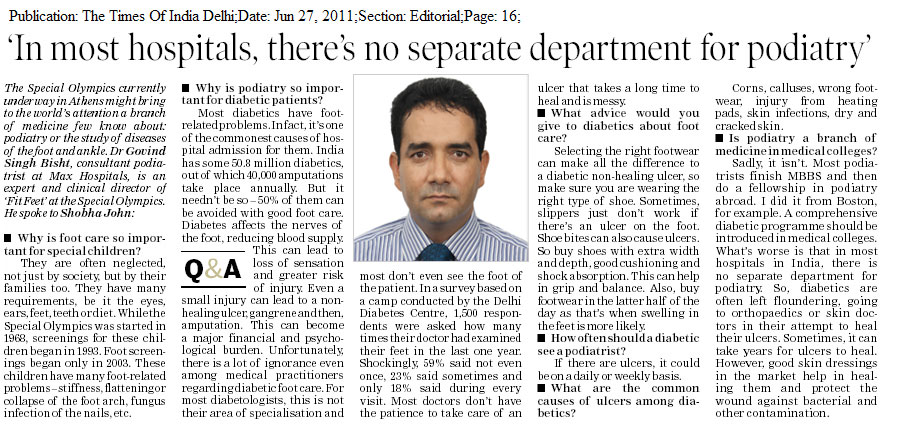Mon to Sat: 7 Pm to 8 PM
Sunday 10.00 to 11.00 AM
Call for Appointment
8851171570
Mon to Sat: 7 Pm to 8 PM
Sunday 10.00 to 11.00 AM
Call for Appointment
8851171570
Doctors in India are giving fresh hope to diabetics who face having one of their feet amputated. An estimated 100,000 Indians with diabetes develop severe ulcers and are forced to have a foot partially or fully removed each year. But a clinic in New Delhi is helping many to avoid surgery and to recover.
The podiatry clinic at the Max Healthcare Medcentre is the first of its kind in South Asia. Dr Govind Singh Bisht, who works at the centre, says the clinic is offering real hope to patients.
"He said staff there have already helped many people to retain feet that would otherwise have been amputated".
Recently, he provided vital medical care to a local man who already had one foot amputated and was facing having his second one removed too.
After almost three months of intensive treatment, Dr Bisht's efforts paid off.
- Nimit Mohan, New Delhi
Ingrown toenails may be caused by cutting the nail improperly, or they may be caused by microtrauma (any inflammation in the nail area), says Dr Govind Singh Bisht, a surgeon in the podiatry department of Max Healthcare, New Delhi. The first step in prevention is cutting the nails straight across, so that the edge of a nail remains on top of the skin. And wear shoes with some room near the toes, as ingrown toenails can be aggravated by shoe rub. You can also cut down on friction by applying a little Vaseline around the edge of the nail and covering it with a Band-Aid. "Some cases need surgery, which is a 30-minute procedure. You'd need 7-10 days to recover," says Dr Bisht.
RELATED STORIES
Historically, the feet are regarded with reverence. Washing the feet of a guest was a mark of respect as was touching and even kissing them in Asian, Egyptian and some European cultures. In contrast, the Chinese are well known for abusing feet, as tiny feet are desirable and symbolise class in women in that culture. Women went to great lengths to prevent their feet from growing; they bandaged them tightly, and also broke the four small toes, bending these under the sole of the foot. After breaking the arch, the foot was then squeezed into shoes three times too small.
Podiatrists are of the opinion that women in India are coming perilously close to harming their own feet too. "Women wear impossibly high heels, too-tight shoes and go for pedicures in unhygienic conditions," says Dr Govind Singh Bisht, podiatrist, Max Healthcare. Painful feet are also ignored, which is unfortunate as pain may be a symptom of other health problems like an impacted back or arthritic knees.
They carry a lot of weight Our feet are a complex structure, each made up of 26 bones, ligaments, tendons and hinge joints and when we stand, our body weight is distributed equally to each of them. When we walk or run, the feet bear almost double the amount of body weight, so its proper distribution is crucial for the health. Most foot problems arise from an improper distribution of our weight, caused by wearing the wrong kind of footwear, an improper posture and gait. If this is not corrected, the constant friction from movement results in conditions like foot corns and calluses, bunions and cracked and painful heels. Over a prolonged period distorted feet and toes, stress fractures, wear and tear of the knee, back problems and constantly painful and tired feet may result. Certain health problems and birth defects can also cause lifelong problems of the foot if not corrected or treated.
"Wearing shoes with narrow and pointed tips and high pointed heels, thin soles and inadequate padding are bad for the health of the feet. Corns and calluses, bunions, tendonitis, arch sprains and stress fractures are some of the conditions which may result from this kind of footwear," says Dr Dave, HOD orthopaedics, Rockland Hospital.
Here are some common problems that result from wearing the wrong shoes:
Corns and calluses CORNS and calluses are common problems that arise when certain parts of the feet are subjected to continuous abnormal pressure. The skin thickens as a bodily response to this pressure resulting in a corn which looks very ugly although the condition itself is harmless. When the thick skin spreads over a large area of the foot, it is called a callus.
All too often people tend to take a blade and attempt to slice off this accumulation of dead skin which can cause cuts and infection. The best way to treat this problem is to apply antibiotic ointments to rid the area of any infection, and use corn caps.
Corn caps are little round plasters which contain salicylic acid which softens the hardened skin while relieving the pressure of that area of the foot. They come in different shapes and sizes, so one can buy them depending on the shape of the corn. The salicylic acid may affect the skin around the corn so to avoid this problem, put some cotton on the area around it and then paste on the cap. If the problem is severe then it is best to see a doctor to have it removed instead of attempting to remove it at home using clippers or blades, adds Dr Dave.


